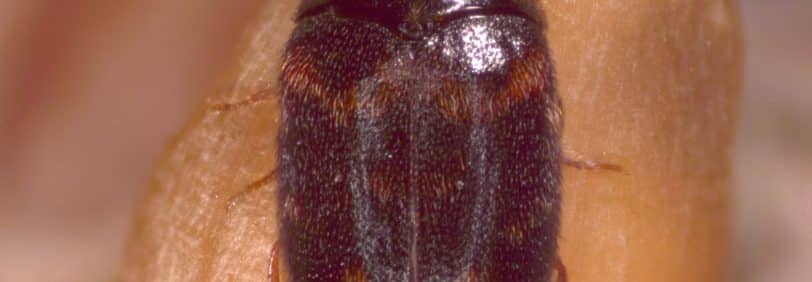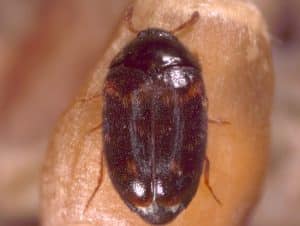Clean bins. The goal is to have bins clean before the next crop. This includes sealing or patching (if necessary) to prevent moisture from getting in, and cleaning to remove stored-grain insects.
–Stored-grain insects. These are not generally a problem in canola because canola is not a hospitable environment for most storage insects. Often insects found in canola storage are those that were in the bin prior to loading from previous cereals or other decaying material, but they generally are unable to survive in a canola bin. Vincent Hervet, stored product entomologist with AAFC in Winnipeg, agrees that while stored-grain insects are not a common problem in Western Canada, he says it could happen. The main species of concern is the warehouse beetle, ‘Trogoderma variabile’, which is a known pest of canola seeds in Australia and it is a common species throughout Canada. (See the photo below.) If canola is kept in bins for longer than usual it could become a problem, Hervet says. This CGC booklet is a general reference for stored grain insects, and includes some info on canola. The CGC website has more on storage tips.
–Insects that enter the bin in harvested grain. In some years, the canola harvest sample can include a lot of grasshoppers, crickets, cabbage seedpod weevils and even flea beetles. Hervet says no insect species that come from the field would be a problem in canola bins in Canada. However, Hervet says Noel White, his predecessor, looked into the potential for grasshoppers to cause spoilage in cereals. White found that dead grasshoppers could induce discoloring of cereal seeds and be the starting point for mold in bins. Hervet: “If there is a lot of dead insects coming from the field, to prevent the development of mold the seeds should be dried as quickly as possible (if moisture content is high). The study was not done on canola unfortunately, but there is a good chance that there would be a similar issue with canola, especially because canola seeds needs a lower moisture content to preserve well.” To be sure, stored canola should be conditioned which will reduce the likelihood of an issue even further.
Keep It Clean. Tips to preserve the market quality for stored canola include:
–Never use malathion to prepare canola for storage or to treat bins used to store canola. Its residue can linger for up to six months, so choose your canola storage bin carefully.
–Make sure your storage bins are free of treated seed and animal protein like blood meal and bone meal.
–Only use approved bin treatments (e.g. diatomaceous earth on cereals).
Adding heaters to aeration systems. With the potential for a lot of canola coming off tough this harvest season, farmers may be shopping for heaters for their aeration fans. Natural gas, electric or propane heaters added before or after (after is better) the aeration fan can greatly improve air’s capacity to dry. Target a heater with output around 72,000 BTU/hour. Read about a farmer’s experience in setting this up.
Tools to make bin monitoring easier. Cables with temperature and moisture sensors can now communicate to your cell phone. Read about some of the options in this Canola Digest article: “New tech check bins”

